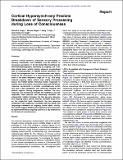Cortical Hypersynchrony Predicts Breakdown of Sensory Processing during Loss of Consciousness
Author(s)
Supp, Gernot G.; Siegel, Markus; Hipp, Joerg F.; Engel, Andreas K.
DownloadSupp-2011-Cortical Hypersynchr.pdf (1.377Mb)
PUBLISHER_POLICY
Publisher Policy
Article is made available in accordance with the publisher's policy and may be subject to US copyright law. Please refer to the publisher's site for terms of use.
Terms of use
Metadata
Show full item recordAbstract
Intrinsic cortical dynamics modulates the processing of sensory information and therefore may be critical for conscious perception [1, 2 and 3]. We tested this hypothesis by electroencephalographic recording of ongoing and stimulus-related brain activity during stepwise drug-induced loss of consciousness in healthy human volunteers. We found that progressive loss of consciousness was tightly linked to the emergence of a hypersynchronous cortical state in the alpha frequency range (8–14 Hz). This drug-induced ongoing alpha activity was widely distributed across the frontal cortex. Stimulus-related responses to median nerve stimulation consisted of early and midlatency response components in primary somatosensory cortex (S1) and a late component also involving temporal and parietal regions. During progressive sedation, the early response was maintained, whereas the midlatency and late responses were reduced and eventually vanished. The antagonistic relation between the late sensory response and ongoing alpha activity held for constant drug levels on the single-trial level. Specifically, the late response component was negatively correlated with the power and long-range coherence of ongoing frontal alpha activity. Our results suggest blocking of intracortical communication by hypersynchronous ongoing activity as a key mechanism for the loss of consciousness.
Date issued
2011-11Department
Massachusetts Institute of Technology. Department of Brain and Cognitive Sciences; Picower Institute for Learning and MemoryJournal
Current Biology
Publisher
Elsevier
Citation
Supp, Gernot G., Markus Siegel, Joerg F. Hipp, and Andreas K. Engel. “Cortical Hypersynchrony Predicts Breakdown of Sensory Processing During Loss of Consciousness.” Current Biology 21, no. 23 (December 2011): 1988–1993. © 2011 Elsevier Ltd
Version: Final published version
ISSN
09609822
1879-0445